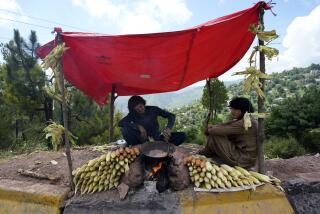Debt-Reduction Strategy
- Share via
Pushed by U.S. Treasury Secretary Nicholas F. Brady, both the International Monetary Fund and the World Bank have now agreed on guidelines to divert as much as $25 billion over the next three years to help developing nations to reduce their debt burdens. In effect, the Brady strategy for debt reduction is under way, although without significant American participation.
The IMF and World Bank have, most wisely, made clear that the prime responsibility still remains with the commercial banks. The response of the banks has been mixed. There have been some helpful agreements on rescheduling small portions of the debt, including the plan worked out this week in Paris to extend for 10 years the deadline for Mexico to pay $2.6 billion. But that affected only marginally Mexico’s total indebtedness of $107.4 billion, of which about 78% is owed commercial banks. And in the broader based negotiations between the banks and the Mexican government in New York, the banks have been resisting the kind of significant and realistic write-offs and other concessions that most observers think are essential.
Guidelines adopted by the IMF and World Bank over the last two weeks are intended to expedite action by the commercial banks to forgive substantial portions of the debts and debt-service interest that were accumulated at a time when the flood of oil-generated dollars encouraged banks to promote lending wherever borrowers could be found. The amount of money available for debt reduction from the two international agencies is miniscule compared to the staggering $1.3 trillion owed by developing nations. But IMF and bank officials are confident that the funds can be leveraged by the debtor nations to win major concessions from the banks, which, sooner or later, will recognize that they will be fortunate to collect even half of the money.
The IMF has already approved three loans, the equivalent of $3.5 billion for Mexico, $825 million for the Philippines and $55 million for Costa Rica, to give each of these nations something with which to negotiate with their creditors. Venezuela is expected to be next.
Michel Camdessus, managing director of the IMF, dressed down French bankers Wednesday with a message intended for all commercial bankers, a reiteration of the firm policy of the IMF and the World Bank that they are in business to bail out indebted nations, not commercial banks.
“Our governors have repeatedly underlined the fact that the official sector cannot continue substituting for the private sector,” Camdessus said. “Do not ignore their message.”
Barber B. Conable, president of the World Bank, issued a similar word of caution Thursday when the bank completed its debt-help guidelines. “Executive directors (of the World Bank) were firm in the view that the bank’s operations should not result in a significant transfer of debt or risk to the public sector.”
At the same time, leaders of the IMF and World Bank have reminded the debtor nations that their eligibility for help will depend on their willingness to accept structural reforms at home that hold out the promise that the debt relief will contribute to authentic economic development.
The developing nations most deeply in debt at the end of 1988 were Brazil, owing $120.1 billion; Mexico, $107.4 billion; Argentina, $59.6 billion; Venezuela, $35 billion; Nigeria, $30.5 billion, and the Philippines, $30.2 billion.
More to Read
Sign up for Essential California
The most important California stories and recommendations in your inbox every morning.
You may occasionally receive promotional content from the Los Angeles Times.













